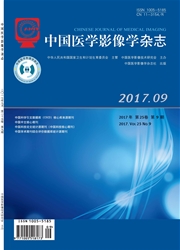

 中文摘要:
中文摘要:
压缩感知是一种全新的信息采集与处理的理论框架,借助信号内在的稀疏性或可压缩性,利用随机投影实现以远低于奈奎斯特频率的采样频率下对压缩数据的采集。该技术应用于医学成像领域,可以加快MRI的扫描速度,减少放射剂量,减少患者的不适。算法首先利用小波系数的稀疏性,保留部分比例最大系数;其次利用改进的最佳正交匹配追踪算法实现基于压缩感知的医学图像二维重构;最后利用最大密度投影算法实现三维体绘制。实验结果表明,局部细节放大图、峰值信噪比以及剖分线的对比,均从定性、定量的角度证明了二维重构算法的准确性和高效性,三维体绘制结果对于诊断及治疗具有很好的辅助作用。
 英文摘要:
英文摘要:
Compressed sensing (CS) is a novel theoretical framework for information acquisition and processing. Taking advantages of the sparsity or compressibility of the signals inherent in the real world, compressed sensing can collect compressed data at the sampling rate much lower than that needed in Shannon's theorem based on random measurement matrix. This technique is used in medical imaging to accelerate MRI's scanning speed, reduce radiation dosage and alleviate patients' suffering. The whole process of the proposed algorithm was as follows: firstly, the wavelet transform was applied to achieve sparse representation of medical images and reserve certain parts with maximal coefficients; secondly, the reconstruction based on CS theory were achieved according to the improved optimized orthogonal matching pursuit (OOMP) algorithm;finally, maximum intensity projection algorithm was used to achieve three-dimensional volume reconstruction. The experimental results demonstrated that our proposed two-dimensional reconstruction method was accurate and effective, which was verified qualitatively by the local detail magnification of images and quantitatively by peak signal-to-noise ratio and sectional comparison. Therefore, the three-dimensional reconstruction can be rather helpful in clinic diagnosis and treatment.
 同期刊论文项目
同期刊论文项目
 同项目期刊论文
同项目期刊论文
 期刊信息
期刊信息
